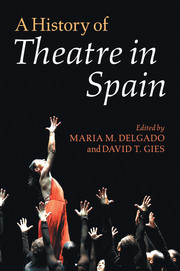Book contents
- Frontmatter
- Contents
- Illustrations
- Contributors
- Acknowledgements
- Introduction
- 1 The challenges of historiography
- 2 Lope de Vega, Calderón de la Barca and Tirso de Molina
- 3 The world as a stage
- 4 Playing the palace
- 5 The art of the actor, 1565–1833
- 6 Theatrical infrastructures, dramatic production and performance, 1700–1759
- 7 Popular theatre and the Spanish stage, 1737–1798
- 8 Theatre of the elites, neoclassicism and the Enlightenment, 1750–1808
- 9 Actors and agency in the modern era, 1801–2010
- 10 Zarzuela
- 11 Nineteenth-century Spanish theatre
- 12 Copyright, buildings, spaces and the nineteenth-century stage
- 13 Modernism and the avant-garde in fin-de-siècle Barcelona and Madrid
- 14 Continuity and innovation in Spanish theatre, 1900–1936
- 15 Theatrical activities during the Spanish Civil War, 1936–1939
- 16 Theatre, colonialism, exile and the Americas
- 17 Theatre under Franco (1939–1975)
- 18 Flamenco
- 19 Nationalism, identity and the theatre across the Spanish state in the democratic era, 1975–2010
- 20 Directors and the Spanish stage, 1823–2010
- 21 This evolution is still ongoing
- 22 Theatre as a process of discovery
- 23 Theatre is the art of the future
- Select bibliography
- Index
- References
13 - Modernism and the avant-garde in fin-de-siècle Barcelona and Madrid
Published online by Cambridge University Press: 05 June 2012
- Frontmatter
- Contents
- Illustrations
- Contributors
- Acknowledgements
- Introduction
- 1 The challenges of historiography
- 2 Lope de Vega, Calderón de la Barca and Tirso de Molina
- 3 The world as a stage
- 4 Playing the palace
- 5 The art of the actor, 1565–1833
- 6 Theatrical infrastructures, dramatic production and performance, 1700–1759
- 7 Popular theatre and the Spanish stage, 1737–1798
- 8 Theatre of the elites, neoclassicism and the Enlightenment, 1750–1808
- 9 Actors and agency in the modern era, 1801–2010
- 10 Zarzuela
- 11 Nineteenth-century Spanish theatre
- 12 Copyright, buildings, spaces and the nineteenth-century stage
- 13 Modernism and the avant-garde in fin-de-siècle Barcelona and Madrid
- 14 Continuity and innovation in Spanish theatre, 1900–1936
- 15 Theatrical activities during the Spanish Civil War, 1936–1939
- 16 Theatre, colonialism, exile and the Americas
- 17 Theatre under Franco (1939–1975)
- 18 Flamenco
- 19 Nationalism, identity and the theatre across the Spanish state in the democratic era, 1975–2010
- 20 Directors and the Spanish stage, 1823–2010
- 21 This evolution is still ongoing
- 22 Theatre as a process of discovery
- 23 Theatre is the art of the future
- Select bibliography
- Index
- References
Summary
By the end of the nineteenth century rapid industrialisation in Catalonia – centred on textiles – had been accompanied by major immigration from central and southern Spain. Madrid too was a rapidly growing city, fuelled by migration from the countryside as people tried to improve their standard of living. Such demographics account for similar patterns in theatre development in the two cities. However, despite the parallels, and a number of overlaps, each city still retained its own individual characteristics and traditions, as this chapter will attempt to illustrate.
Barcelona
In the late nineteenth century, Barcelona society was wracked by conflict, the mushrooming Anarchist movement in many ways the counterpoint to rampant capitalism. At the same time, demands for Catalan autonomy grew as the industrial classes found central Spanish governments – rooted in rural interests – unresponsive to the needs of the new markets. Although there is a divergence of critical opinion as to whether it was essentially a bourgeois or a working-class phenomenon, Catalan nationalism crossed the social divide. Spanish was the language of most of the immigrants, while Catalan was widely spoken among the middle and skilled working classes. Following a long decline of Catalan power and culture since the ‘unification’ of Spain in 1492, and more particularly after the early eighteenth century, the long road to recovery had begun in the mid-nineteenth century. During this cultural renaissance, known as the Renaixença, Catalan had re-emerged as a literary language after three centuries of confinement to virtual patois status. While the Renaixença was in many ways a rural phenomenon that drew its inspiration from the medieval period, the modernista movement that became the main cultural driver during the 1890s and 1900s was much more internationally focused. During this period Catalonia avidly absorbed the latest movements in the arts, especially from northern Europe. Modernisme (Catalan art nouveau) was a key feature in the development of the theatre during the period, and, significantly, when noucentisme (classicalist movement) replaced it as the dominant force in the 1910s, the noucentistes' general lack of interest in the theatre was reflected in a lessening of mainstream theatrical activity. We use the word ‘mainstream’ advisedly, since another world of theatrical – or rather paratheatrical – activity was centred in the ‘low-life’ area of Barcelona during the period under discussion, in particular the emblematic Avinguda del Paral·lel, which runs from the port area of the city to the Plaça d'Espanya.
- Type
- Chapter
- Information
- A History of Theatre in Spain , pp. 264 - 281Publisher: Cambridge University PressPrint publication year: 2012



